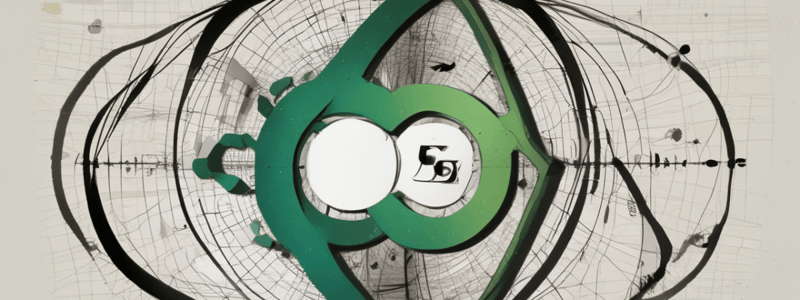Podcast
Questions and Answers
What is the unit of the decay constant (λ)?
What is the unit of the decay constant (λ)?
- h-2
- s
- s-1 (correct)
- min-1
What is the unit of λ in the equation A = λN?
What is the unit of λ in the equation A = λN?
- min-1
- h-1
- s-1 (correct)
- s
What does the half-life (t1/2) represent?
What does the half-life (t1/2) represent?
- The time it takes for the activity to double
- The time it takes for the activity to drop to zero
- The time for half of the radioactive nuclei in a given sample to undergo decay (correct)
- The time it takes for the activity to triple
What is the relationship between λ and t1/2?
What is the relationship between λ and t1/2?
What is the activity of the sample of Radon in Example 4?
What is the activity of the sample of Radon in Example 4?
What is the formula to calculate the number of remaining radioactive nuclei (Nt) after a period of time?
What is the formula to calculate the number of remaining radioactive nuclei (Nt) after a period of time?
What is the half-life of Tc-99 in Example 5?
What is the half-life of Tc-99 in Example 5?
What is the formula to calculate the activity of Tc-99 after 2 days in Example 5?
What is the formula to calculate the activity of Tc-99 after 2 days in Example 5?
What is the initial activity chosen for the plot?
What is the initial activity chosen for the plot?
What is the shape of the decay curve for all radionuclides?
What is the shape of the decay curve for all radionuclides?
What is the definition of absorbed dose?
What is the definition of absorbed dose?
What are the two important categories of radiation dose?
What are the two important categories of radiation dose?
What is the unit used to measure absorbed dose in the SI system?
What is the unit used to measure absorbed dose in the SI system?
What is the formula to calculate the absorbed dose?
What is the formula to calculate the absorbed dose?
1 Gy is equal to how many rad?
1 Gy is equal to how many rad?
What is the unit used to measure dose equivalent in the SI system?
What is the unit used to measure dose equivalent in the SI system?
What is the formula to calculate the dose equivalent?
What is the formula to calculate the dose equivalent?
What is the purpose of the weighting factor (Q) in radiation dosimetry?
What is the purpose of the weighting factor (Q) in radiation dosimetry?
What is the dose equivalent in Sv for a radiation dose of 200 rem?
What is the dose equivalent in Sv for a radiation dose of 200 rem?
What is the factor that affects radiation dose due to differences in population or individual?
What is the factor that affects radiation dose due to differences in population or individual?
What is the result of direct ionization of DNA or other structures by radiation?
What is the result of direct ionization of DNA or other structures by radiation?
What is the radiation safety principle for minimizing radiation doses?
What is the radiation safety principle for minimizing radiation doses?
What is the unit of radiation dose equivalent to 1 Sv?
What is the unit of radiation dose equivalent to 1 Sv?
What type of radiation interaction involves the creation of free radicals?
What type of radiation interaction involves the creation of free radicals?
What is the primary goal of the ALARA principle?
What is the primary goal of the ALARA principle?
Which of the following principles is most effective in reducing radiation exposure?
Which of the following principles is most effective in reducing radiation exposure?
What is the purpose of wearing protective lead shielding and thyroid collars?
What is the purpose of wearing protective lead shielding and thyroid collars?
What is the relationship between radiation intensity and distance from the source?
What is the relationship between radiation intensity and distance from the source?
What is the formula that represents the inverse square law?
What is the formula that represents the inverse square law?
What is a necessary condition for applying the inverse square law?
What is a necessary condition for applying the inverse square law?
The ALARA principle is only a sound safety principle, but not a regulatory requirement.
The ALARA principle is only a sound safety principle, but not a regulatory requirement.
The three principles of radiation protection are time, shielding, and mass.
The three principles of radiation protection are time, shielding, and mass.
The intensity of the radiation source increases as the distance from the source increases.
The intensity of the radiation source increases as the distance from the source increases.
The inverse square law can be applied to any type of radiation source.
The inverse square law can be applied to any type of radiation source.
Wearing protective lead shielding and thyroid collars can protect the radiosensitive areas of the body when it is required for the technologist to be near the source of radiation.
Wearing protective lead shielding and thyroid collars can protect the radiosensitive areas of the body when it is required for the technologist to be near the source of radiation.
Reducing external radiation exposure can be achieved by increasing time spent in the radiation area.
Reducing external radiation exposure can be achieved by increasing time spent in the radiation area.
The distance principle is the most effective way to reduce radiation exposure.
The distance principle is the most effective way to reduce radiation exposure.
Shielding should be used only when the time and distance principles are not possible.
Shielding should be used only when the time and distance principles are not possible.
The radiation intensity is directly proportional to the square of the distance from the source.
The radiation intensity is directly proportional to the square of the distance from the source.
The primary goal of radiation safety is to eliminate all radiation exposure.
The primary goal of radiation safety is to eliminate all radiation exposure.
Flashcards are hidden until you start studying




